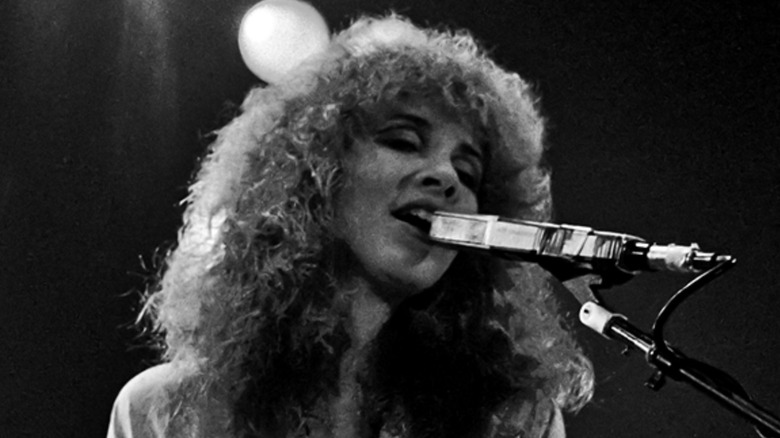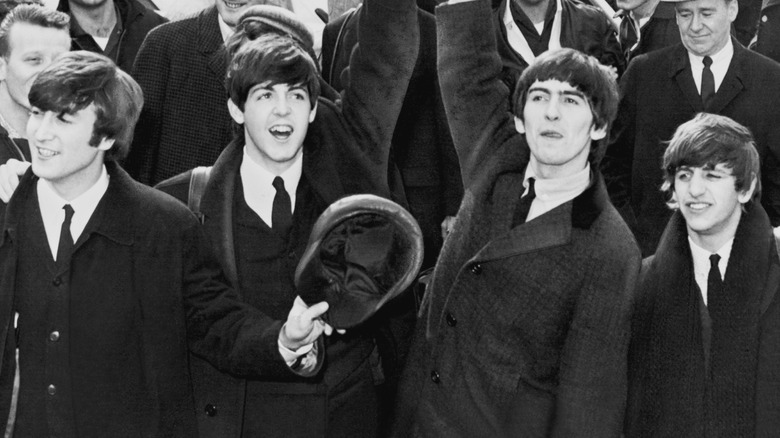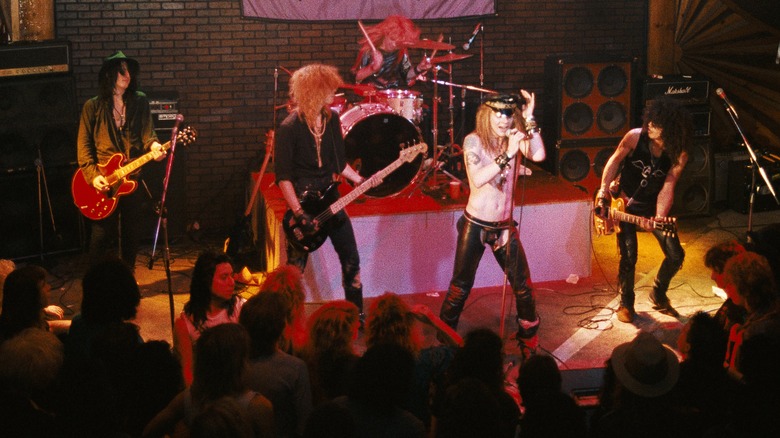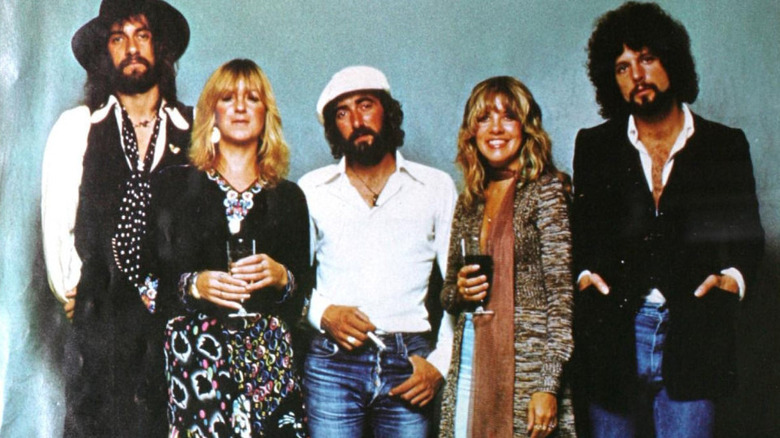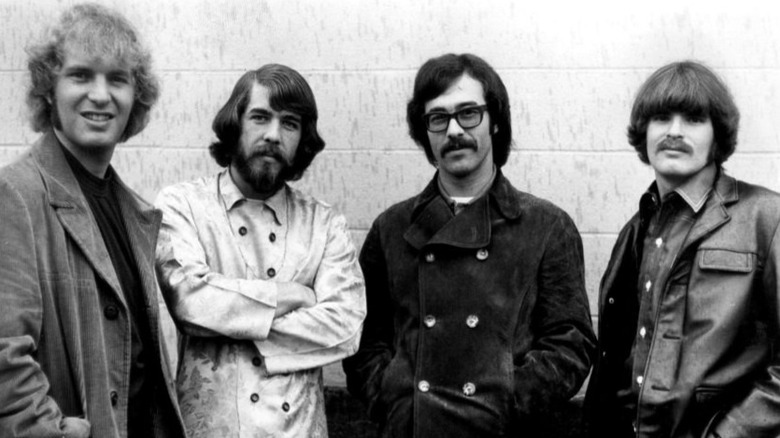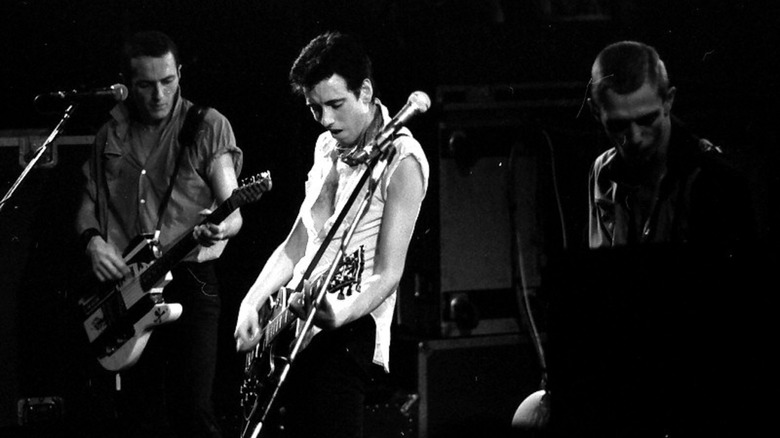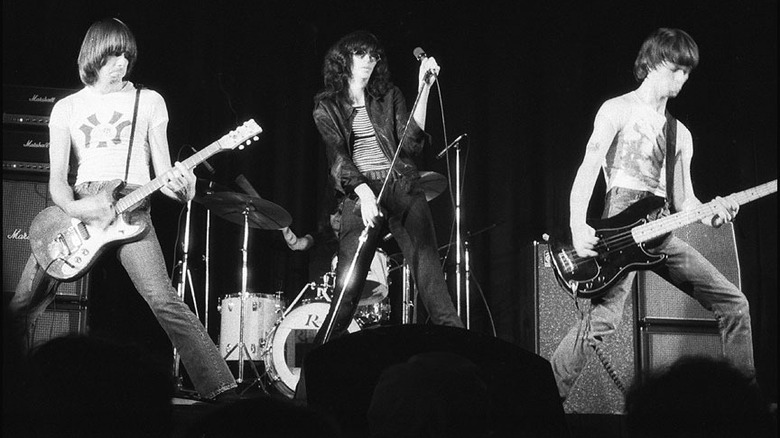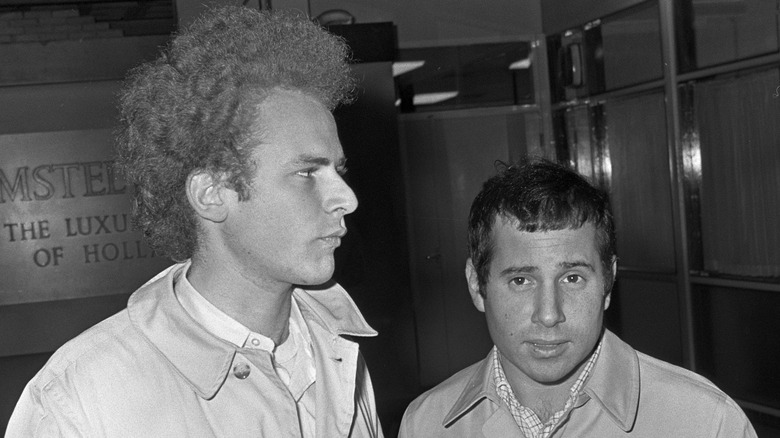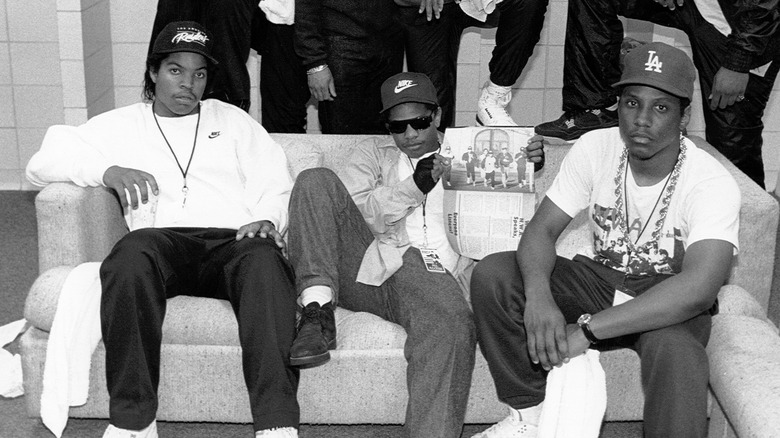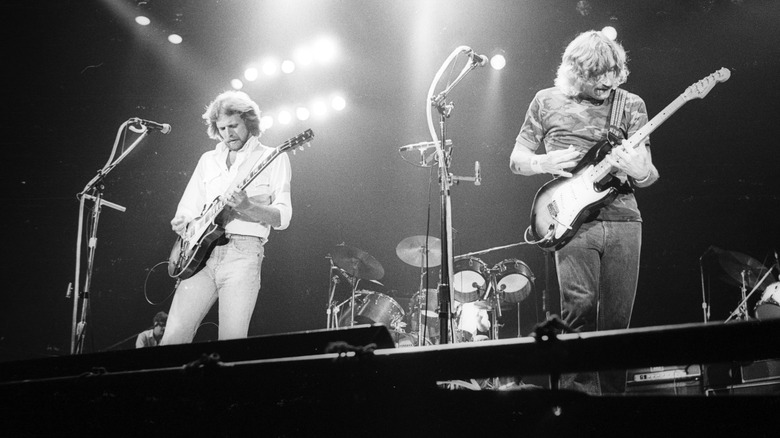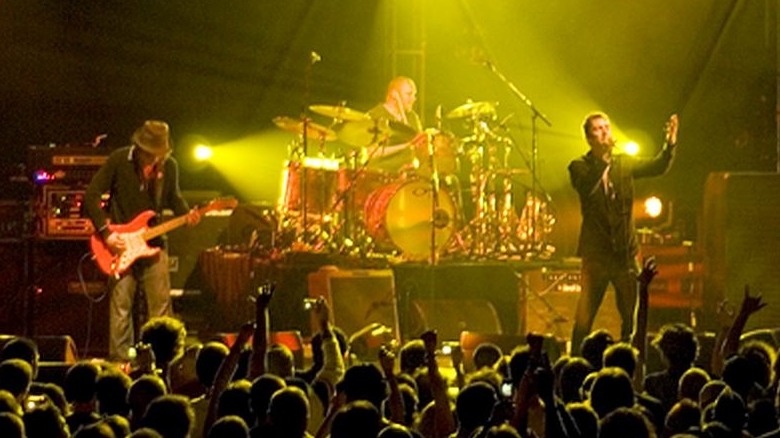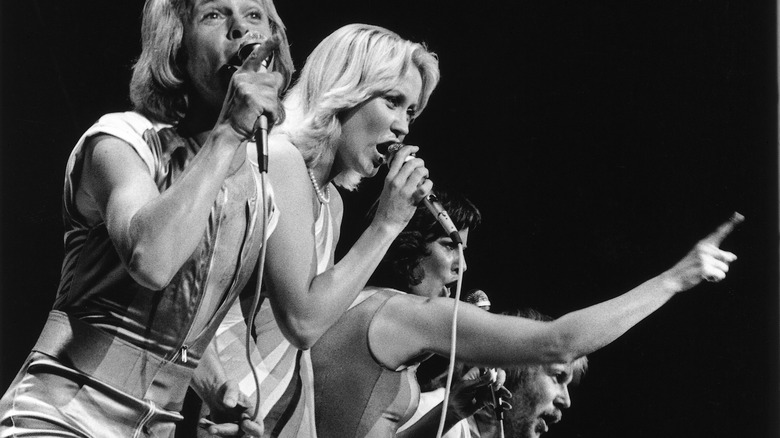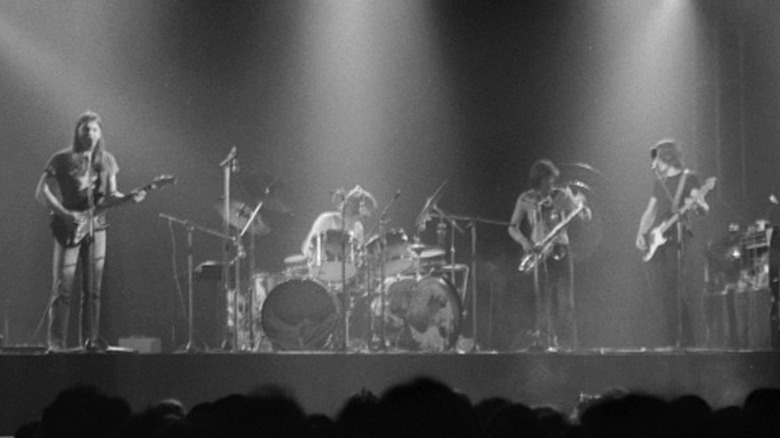Albums That Tore These Bands Apart
Making music isn't always harmonious. Sometimes coming together to create an album is the final straw that breaks a band apart. Ironically, the end result — other than the discord in the band — isn't always a musical disaster. As you'll see from this list, some albums that are now considered masterpieces were born out of bitterness, battles for creative control, and deeply personal disagreements.
One major warning sign that an album is destined to tear apart the very band that's creating it is one member taking control of the musical direction, and disregarding everyone else's input. Take note, would be self-appointed band leaders: this tends to make the other members resentful and potentially mutinous. Another issue that has destroyed many bands before their time is substance abuse. Even if a band has other issues, this tends to exacerbate everything. (If you or anyone you know is struggling with addiction issues, help is available. Visit the Substance Abuse and Mental Health Services Administration website or contact SAMHSA's National Helpline at 1-800-662-HELP (4357).) Oh, and never invite couples to be part of your band, unless you think they'll function well as exes. Music may be the food of love, but when things go sour with the relationship, so follows the band.
The stories of albums that have torn bands apart involve similar elements: jealousy, betrayal, creative divergences. Yet each one is also a unique chapter in each band's life, and often (but not always) the final one.
Tension in The Beatles came to a head on Let It Be
Despite the "live and let live" message of its titular song, The Beatles were not feeling very collaborative when they made "Let It Be." According to the Independent, divisions emerged as early as 1966, when guitarist George Harrison threatened to quit, resentful that his contributions were not taken as seriously as those of celebrated partnership Paul McCartney and John Lennon. McCartney seemed to be taking control of the band, and a meditation retreat to India in 1968 proved that the four band members were divided spiritually as well as creatively.
It was there that Lennon started his adulterous relationship with Yoko Ono. Ono didn't "break up the Beatles." But Lennon's bandmates resented his insistence on bringing her to the recording sessions for "The White Album" in 1968. That album nearly broke up the band, but the following year, they reunited for "Let It Be." McCartney's controlling tendencies, Lennon's heroin addiction and insistence on only speaking to his bandmates through Ono, and Harrison's creative frustrations made the sessions tense. Harrison temporarily quit again, but was coaxed back.
The Beatles recorded another album together, "Abbey Road," months later. By the time it came out in September 1969, Lennon had quit (or so he claimed.) In April 1970, McCartney issued a statement saying he didn't plan to release more music with The Beatles, sealing the band's fate. The following month, "Let It Be" was released, but The Beatles were already over.
Guns N' Roses imploded while making Use Your Illusion I & II
In 1987, Guns N' Roses' prophetically titled debut album "Appetite for Destruction" turned them from L.A. legends to national superstars. Entering the big time escalated the band's chaotic lifestyle, and ultimately cracked its foundations.
Between "Appetite," second album "GN R' Lies" (released in 1988), and 1991's two-volume album "Use Your Illusion I & II," most of the band members fell into major drug addictions. Rolling Stone reports that the band spent a lot of time touring, which fueled the drink and drug abuse. And when they were back in LA, they grew apart. By the time the "Illusion" sessions started, rhythm guitarist Izzy Stradlin was newly sober, but drummer Steven Adler had been kicked out, because his drug use was interfering with his playing. However, guitarist Slash and bassist Duff McKagan, in particular, were still taking lots of drugs, to Stradlin's distress. And frontman Axl Rose was leaning into his reputation as an egomaniac, delaying when they would go onstage, walking offstage mid-gig, and fighting fans. One incident in St. Louis, months before the album came out, caused a notorious riot.
The "Illusion" double album was well-received, but it had pushed the band to breaking point. Stradlin officially left two months after its release. Covers album "The Spaghetti Incident?," which had been mostly recorded during the "Illusion" sessions, wasn't a big hit in 1993. And in 1996, Rose's egomania pushed Slash to quit, followed by McKagan a year later.
The classic Fleetwood Mac line-up survived Rumours but not Tango in the Night
The drama that inspired Fleetwood Mac's 1977 album "Rumours" has become rock history. In short, the two couples that made up four-fifths of the band were breaking up. Half of each ex-couple got involved in a new romance with someone else involved with the band. Most notably, during the album tour, singer Stevie Nicks and remaining fifth of the band, drummer Mick Fleetwood (also recently divorced), had an affair.
Somehow, Fleetwood Mac not only survived "Rumours," it became one of the best-selling, most critically beloved albums of all time. Two albums and world tours later, in 1982, the band went on hiatus. Singers Nicks and Christine McVie and guitarist Lindsey Buckingham — Nicks' ex — all worked on solo careers, but only the two singers found success, to Buckingham's frustration.
In 1985, Buckingham was working on another solo project: but Fleetwood convinced him to share his songs with the group instead. By then, Fleetwood and Nicks were taking even more drugs — mainly cocaine — than they had during the "Rumours" sessions. The album was being recorded at Buckingham's house, and he didn't appreciate the raucous parties his bandmates were hosting there. Once "Tango in the Night" was finished, Buckingham quit Fleetwood Mac. He joined a long list of former members, as Rolling Stone reports: but it marked the end of the band's peak. He returned in 1996, but was fired in 2018, supposedly at Nicks' insistence.
Creedence Clearwater Revival could not be resuscitated after Mardi Gras
Creedence Clearwater Revival was built on contradictions: a folksy, bluesy, 1950s Deep South sound from a 1970s Northern Californian band. A foursome of brothers and childhood friends that hit — and fell out — big time. Stu Cook, Doug Clifford, and John Fogerty formed what became CCR in 1959, when they were 14. Soon John's older brother Tom joined. In 1967, their new record label propelled their self-titled album to mainstream popularity. Keen to capitalize on the commercial success, John pushed his bandmates to constantly release new music: they put out three albums and toured major festivals in 1969 alone.
But John's bandmates grew tired of his controlling behavior. In 1971, Tom quit the group, sick of being ordered about by his little brother. That year, the remaining members regrouped for a new album. But Tom's exit and John's egomania doomed it from the start. There are multiple versions of what happened next, as Uncut reports. According to John, Cook and Clifford threatened to quit if they weren't allowed to write and sing a third of the new album. According to Cook and Clifford, John cornered them in a limo, and told them they were fired if they didn't write and sing a third of the new album.
Clifford and Cook maintain that John deliberately sabotaged the band, knowing his voice was CCR's characteristic sound. Sure enough, "Mardi Gras" was a flop, and the band broke up in 1972.
Combat Rock sums up The Clash's final years
By 1982, the Clash had done the impossible for a British band: built a fanbase in America. Their fifth album, "Combat Rock," pushed them into mainstream success Stateside, with singles "Rock the Casbah" and "Should I Stay or Should I Go" still considered classics.
But the latter song soon took on new meaning. Over the previous five years, drummer Nick "Topper" Headon's drug use had escalated into a full-blown cocaine and heroin addiction. Although he was still effective in the studio — he played drums, bass, and piano and mostly wrote "Rock the Casbah" — on tour he had become a liability. At a gig in Amsterdam supporting the "Combat Rock" album, frontman Joe Strummer fired Headon, the Independent reports.
Strummer didn't stop there. While making "Combat Rock," guitarist and singer Mick Jones, who wanted to explore hip hop and synthesizers, had grown frustrated with Strummer's insistence on controlling the band's musical direction. Jones also argued with bassist Paul Simonon and notorious manager Bernie Rhodes. He even made his own mix of what became "Combat Rock," titled "Rat Patrol From Fort Bragg," but the rest of the band nixed it.
During a hiatus that dragged into 1983, the band was barely speaking. On September 10, Strummer and Simonon released a statement, effectively firing Jones. He and Headon were replaced, and a third guitarist added: but the Clash's final album, "Cut the Crap," literally failed to deliver on its promise, and the band disintegrated.
The Ramones said ¡Adios Amigos! after years of bitter rivalry
The fact the Ramones made it more than 20 years is a punk rock miracle. For much of their two decades, singer Joey and guitarist Johnny refused to speak to each other. The original Ramones line-up was Joey, Johnny, bassist Dee Dee, and drummer Tommy. They all took the surname Ramone, but none of them were related, except in their shared outsiderness.
Quiet, anxious, and an aspiring hippie, Joey was always the polar opposite of loud, violent-tempered, right-wing Johnny. According to Rolling Stone, Johnny admitted in his autobiography that they'd never got on very well. But in 1982, polite dislike turned to outright hostility, when Joey's girlfriend Linda Danielle left Joey for Johnny, and later married him. Neither Joey nor Johnny left the band, but they didn't exchange a civil word for the next 14 years, even while fronting the Ramones together. Tommy had left in 1978, tired of touring and Johnny's tantrums. And in 1989, the always erratic Dee Dee left to start a rap career.
With the only two founding members caught in an unfixable feud, Johnny decided that the band was over. "¡Adios Amigos!" was released on July 18, 1995, and the Ramones (with replacements Marky on drums and C.J. on bass) played their final show on August 6, 1996, at the Hollywood Palace. Dee Dee died of a heroin overdose four years later. When Joey died of lymphoma in 2001, Johnny didn't attend the funeral.
Simon & Garfunkel's issues boiled over on Bridge Over Troubled Water
Paul Simon and Art Garfunkel were thrown together by chance and forced together by success. The pair started singing and playing music as a duo as teenagers. They reunited after college and were signed by Columbia Records, partly thanks to the song "The Sound of Silence," famous for the line "Hello Darkness, my old friend." Their debut album flopped, and they temporarily split again. But a DJ's interest in the song and a slightly remixed version suddenly made them the band of the moment.
They kept putting out albums, but on the inside, the duo was pulling in different creative directions. Simon wanted to work on solo projects, and Garfunkel was trying to pursue a movie career. This became a direct source of tension in 1969, when director Mike Nichols cut Simon from his movie adaptation of "Catch 22," but gave Garfunkel fourth billing, the Guardian reports. Simon's hurt feelings were not helped by the fact the shoot ran late, moving the timeline on their next album.
"Bridge Over Troubled Water" is most famous for its title track: but Simon's feelings about that song demonstrated the discord in the duo. He later admitted that he resented watching Garfunkel singing his song and receiving the credit, in a way he never had before. The album won the Grammy for Album of the Year 1970, and was number one for 10 weeks, but it wasn't enough to keep the duo together.
N.W.A. lost two core members over album rights
In the case of N.W.A., it wasn't the creative process of making an album that led to the breakup of the band, but disputes over royalties from that album. Released in 1988, the group's debut album, "Straight Outta Compton," struck a chord, especially with disenfranchised Black teens and young adults. Many identified with what N.W.A. would continually defend as a realistic portrayal of the challenges of growing up in an impoverished urban area, compounded by systemic racism.
However, even as the album became a hit nationwide, inside the band, resentments over payment were growing. One writer and rapper on "Straight Outta Compton," Arabian Prince, had quit before the album even came out, because he felt royalties weren't being distributed fairly, according to Rolling Stone. During the tour to promote the album, Ice Cube left the group rather than accept the $75,000 check he saw as less than his fair share of payment. NME reports that he and the other members were also angry that they hadn't received royalty payments for their work on Eazy-E's self-proclaimed solo album "Eazy-Duz-It," which they felt they had contributed to equally.
N.W.A. and Ice Cube continued to make music, including tracks that directly attacked each other. But after the release of the group's second album, "Efil4zaggin," Dr. Dre decided he was also dissatisfied with his contract, and left for a solo career. The remaining members occasionally worked together, but never as N.W.A.
The Eagles cracked under the pressure of following Hotel California
You'd think that creating an album deemed by the band, the fans, and the world as the best thing you've ever made would bring a group together. But alas, when the Eagles reached their zenith with 1976's "Hotel California," the only way was down.
Ironically, it was being a set of Midwestern outsiders that gave the band the perspective that led to the song "Hotel California," an allegory about the destructiveness of the hedonism at the heart of the LA music scene. Or Satanism, cannibalism, or heroin addiction, the BBC notes: even the band doesn't know. Talking about how the group came up with its most famous song, guitarist Don Felder told MusicRadar: "Everybody [in the band] had driven into Los Angeles ... as you drive in through the desert at night, you can see the glow ... from a hundred miles away."
The band was all too aware that it had created a masterpiece. As the album and song became huge hits, internally, the Eagles struggled to figure out what to do next. Singer Glenn Frey admitted to the Independent that they felt that they'd used up all their lyrics and creativity on "Hotel California." Making follow-up "The Long Run" was a three-year slog, culminating in a physical fight at a gig between Felder and Frey that confirmed it was time to call it quits. "I've always explained The Eagles' break-up in two words, 'Hotel California,'" Frey said.
The Verve's Forth is final
The Verve became famous for their innovative approach to Britpop — and for keeping the third album from Britpop titans (and Verve collaborators) Oasis off the number one spot. Then the Verve became even more famous for their dramatic breakups, reunions, and breakups.
The first split came in 1993, three months after the band's second album, "A Northern Soul," was released to rave reviews. Making that album had been a drug-and-drink-fueled rock n' roll disaster, and all the members were exhausted, their relationships frayed. It didn't help that frontman Richard Ashcroft dominated the group, refusing to accept anyone else's creative input. However, weeks later, Ashcroft decided that the Verve could put their differences aside for the sake of making the most of this success: but without guitarist Nick McCabe. McCabe was allowed back for the band's 1997 magnum opus, "Urban Hymns." But two years after that, they split again.
In 2007, Ashcroft persuaded McCabe and bassist Simon Jones to record another Verve album, "Forth." McCabe later told Gigwise that he was frustrated that the typically raw Ashcroft seemed to be holding back lyrics he felt were too personal. Two years later, in August 2009, the Guardian reported that McCabe and Jones hadn't spoken to Ashcroft for a year. A source said that the pair considered the Verve finished for good, and that the experience touring and making "Forth" had convinced them that Ashcroft had only recorded the final Verve album to boost his solo career.
Most of ABBA ghosted each other after The Visitors
By 1981, the members of ABBA were ready to step away from the group that had propelled them to glittery jumpsuit-clad fame. The two marriages at the center of the band had broken up. Guitarist and songwriter Björn Ulvaeus and singer Agnetha Fältskog had announced their divorce in 1979, an experience recounted in Ulvaeus' song "The Winner Takes It All," sung by Fältskog, on ABBA's 1980 album "Super Trooper." And four weeks before starting work on ABBA's eighth album, "The Visitors," in March 1981, pianist and songwriter Benny Andersson and singer Frida Lyngstad announced their separation.
According to the Telegraph, Ulvaeus and Andersson were looking to escape ABBA for professional reasons, too. Having spent the last seven years pumping out glitzy pop hits, the pair wanted to try something new: like, say, musicals.
By the time the band came to record "The Visitors," Ulvaeus was dating his future second wife. Fältskog later admitted that she was hurt that he'd moved on so fast, and that she felt deeply depressed. Andersson, meanwhile, who had cheated, was reportedly on the edge of a nervous breakdown. And longstanding tensions between the two singers occasionally boiled over too. These feelings spilled onto tracks like "One of Us" and "Slipping Through My Fingers." Even after the album was released, ABBA didn't announce a breakup: but all of the members moved on to other projects, silently agreeing that the band was done.
The Wall caused divisions among Pink Floyd
The band known as Pink Floyd technically survived the making of "The Wall," but it would never again involve the same four members. Pink Floyd had become superstars five years before they started working on "The Wall," with 1973's "The Dark Side of the Moon." It was on this album, according to Rolling Stone, that bassist and singer Roger Waters started to assert himself, writing every lyric.
The band responded to the pressure of following a massive success by ceding more creative control to Waters during follow-up albums "Wish You Were Here" in 1975, and "Animals" in 1977. But his freehanded rejection of the other members' contributions started to rankle. For "The Wall," Waters presented the other members with two concepts to choose from, according to the Conversation: "Bricks in the Wall" and "The Pros and Cons of Hitch Hiking." They settled on the former, specifically on a story about a musician called Pink Floyd (a thinly veiled Waters) and his struggles with isolation. Again, Waters refused to include their contributions, or to credit them on songs, and he even replaced drummer Nick Mason on one track.
Ultimately, "The Wall" was another big hit, but the cracks were too deep to overcome. Keyboardist Richard Wright left after the album was released in 1979, followed by Waters himself in 1985. Waters ultimately lost a naming rights lawsuit against Mason and guitarist David Gilmour. In March 2021, Gilmour announced that an attempted reunion had failed.
The Smiths' musical influences sharply diverged
Unlike some bands on this list, gloomy wordsmiths The Smiths were feeling pretty good about the album they had gathered to make in March 1987, according to the Independent. Yes, frontman Morrissey's early bedtimes and anti-drugs attitude isolated him from songwriter and guitarist Johnny Marr, bassist Andy Rourke, and drummer Mike Joyce. And yes, Marr was frustrated that Morrissey had recently forced out manager Matthew Sztumpf, leaving Marr to take on the thankless and boring band admin.
However, initially, everyone was optimistic. Morrissey and Marr clicked creatively precisely because they were different: charismatic, proudly weird Morrissey complemented brooding, reserved Marr. Unfortunately, those differences ultimately stretched too far. Morrissey wanted to move towards a more mainstream sound, suggesting a cover of pop star Cilla Black's "Work is a Four-Letter Word," while Marr was determined to experiment with something more mature. Tensions came to a head when Morrissey refused to shoot a video in the name of promoting the band in America. He also convinced the rest of the band to force Marr to fire Sztumpf's replacement, meaning a return to managerial duties.
Marr finally told the others that he was leaving to work with the Talking Heads. It was unclear that the break would be permanent until a few months later, when NME declared that the Smiths had broken up. Although their source is unknown, Marr confirmed the story. "Strangeways, Here We Come" was released months later, at which point the band was officially over.
